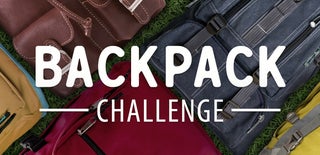Introduction: Backpack Thermal Lunch Pocket
This is my first instructable, so please bear with me.
As a train commuter i always enjoy a bottle of fresh water, so a few years ago i made an insulated dress for my plastic bottle. Now i decided to step up a level and make an insulated backpack pocket for my lunch. So a thermal bag tailored on my backpack pocket, which could fit my bento and a half liter bottle.
I'm participating in the Backpack Challenge, so if you like my work please vote for me!!
Step 1: Materials and Tools
Materials:
-reflective foil (like the windshield sunshade)
-cotton tape
-velcro strips (optional)
Tools:
-scissors
-ruler
-pencil
-needle and thread
-double sided tape
Step 2: Measuring and Drawing
First is to measure your backpack pocket to understand how big the lunch pocket is gonna become. Then is to decide what to use and how to open and close it. I chose to make a detachable bag and to close it by folding it, to keep it simple, instead of lining my actual bag pocket.
Step 3: Cutting It Out
To reach decent performance i decided to use a multilayered material: a bubble wrap sheet between two reflective insulating foil (like the car windshield sunshade). Total thickness 16mm.
I'm going to sew it together, so I'll need some cotton tape to finish it up, and some velcro strips to fix it to the backpack.
Start by cutting the pieces you're gonna sew. Then loosely put them together to imagine where you're gonna get. My bag is 20cm long, 22cm wide and 4cm high, with an extra 10cm length to fold it over. When sizing the "fabric" it's important to consider where to put the seams and give them enough space. Given the thickness and toughness of the material sewn i left 1cm extra.
pieces needed:
-2 strips of reflective layer 24cm (22+1+1) x 65cm or more
-4 strips of reflective layer 6cm (4+1+1) x 30cm
-1 strip of bubble wrap layer 24cm x 50cm or more
-2 strips of bubble wrap layer 6cm x 20cm
Step 4: Putting Together the Back...
The strips are to be composed in a multilayered sheet. The bigger one is to be folded on itself to make the front and back of the bag. The smaller ones are the sides.
Notice the bubble wrap is shorter than the reflective layer. This is to keep the folding flap thinner and easier to fold.
I wanted to use a sewing machine to do this, but the silver-coated plastic is too slippery for my machine and the result was horrible. the stitches were so close it cutted the plastic in two. I suggest trying on a scrap piece of "cloth" to see how it goes before touching your actual work.
Sewing by hand has a mayor advantage here: it is possible to fix layers and cotton tape in place with some double sided tape, then sew through it without worring about the glue (you'll probably have to dispose of your needle when finished). Do not try to do this with a sewing machine!
Notice that it's actually the seam that's keeping the bag together, so don't slack on them.
The material used is pretty thick so it's important to keep in mind that when folded it wont keep the shape and it's gonna have wrinkles. But! If you fold it before fixing the layers together everything will go smooth with a good shape and no wrinkles.
So start with fixing only the layers of the back face of the bag and sew the sides on it. Once that's done fold the front face over and fix its layers. When its folded and the layers fixed you can cut the strip to measure.
I strongly suggest to tack the pieces together before actually sewing them. It might seem lost time, but it makes a difference. When i sewed it the first side wasn't tacked, the others were. You can see the difference in the pictures.
Step 5: ... and the Front
Once the back is done you can fold the front up, cut its layer one at a time to measure and fix them with double-sided tape.
Now fold the sides out on themselves and clamp them in place, so it's easier to tack them. Then fix the cotton tape with the double-sided tape like in the picture. It makes it easier to sew it.
Step 6: Finishing Touches
The only thing it's left to do is to sew the remaining yellow tape and to provide a mean to keep the bag closed.
I used some bright blue cotton tape wound around it.
Step 7: That's It!
Here it is! In my bag pocket and with some food in it!!
It works pretty well in keeping water and lunch fresh.
Enjoy!
Paleseu is a participant in the Amazon Services LLC Associates Program, an affiliate advertising program designed to provide a means to earn advertising fees by advertising and linking to amazon(.com, .co.uk, .ca etc) and any other website that may be affiliated with Amazon Service LLC Associates Program.

Runner Up in the
Backpack Challenge











